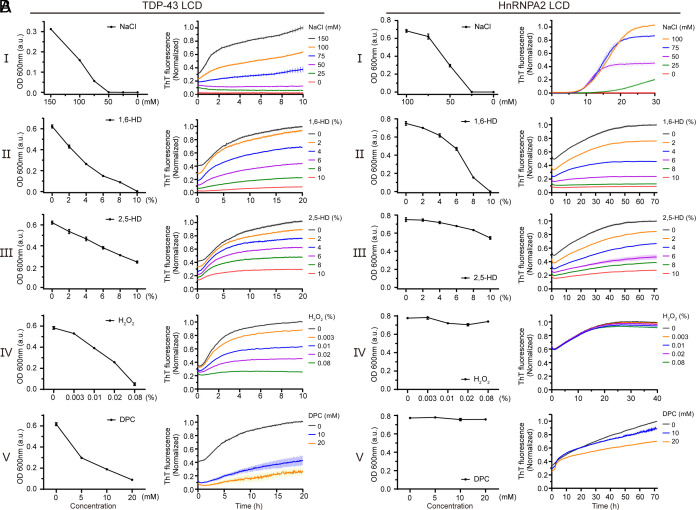Fig. 4.
Effects of hypotonic buffer conditions, aliphatic alcohols, methionine oxidation, and a lipid mimic on phase separation and cross-β oligomerization of the TDP-43 and hnRNPA2 LCD. (A) A purified sample of the TDP-43 LCD was allowed to become phase separated in buffer of neutral pH and physiologically normal levels of monovalent salt prior to five conditions of experimental manipulation. Sequential reduction in monovalent salt concentration melted phase-separated droplets as measured by turbidity (I). Exposure to 1,6-HD melted liquid-like droplets as a function of alcohol concentration (II). Diminished droplet melting was observed upon exposure to 2,5-HD (III). Significant droplet melting was observed upon exposure to hydrogen peroxide (IV) or nonionic lipids (V). Formation of cross-β polymers by the same protein sample was monitored by acquisition of thioflavin-T fluorescence (Materials and Methods). Right panels show impediments to cross-β polymerization effected by sequential reduction in monovalent salt concentration, exposure to 1,6-HD, exposure to 2,5-HD, exposure to hydrogen peroxide, or exposure to the lipid mimic DPC. (B) Parallel experiments performed with the purified sample of the hnRNPA2 LCD. Reduction in salt concentration and exposure to aliphatic alcohols effected similar changes upon both phase separation and cross-β polymerization for the hnRNPA2 LCD as observed for the TDP-43 LCD. Neither hydrogen peroxide nor the DPC lipid mimic affected either phase separation or cross-β polymerization of the hnRNPA2 LC domain.

